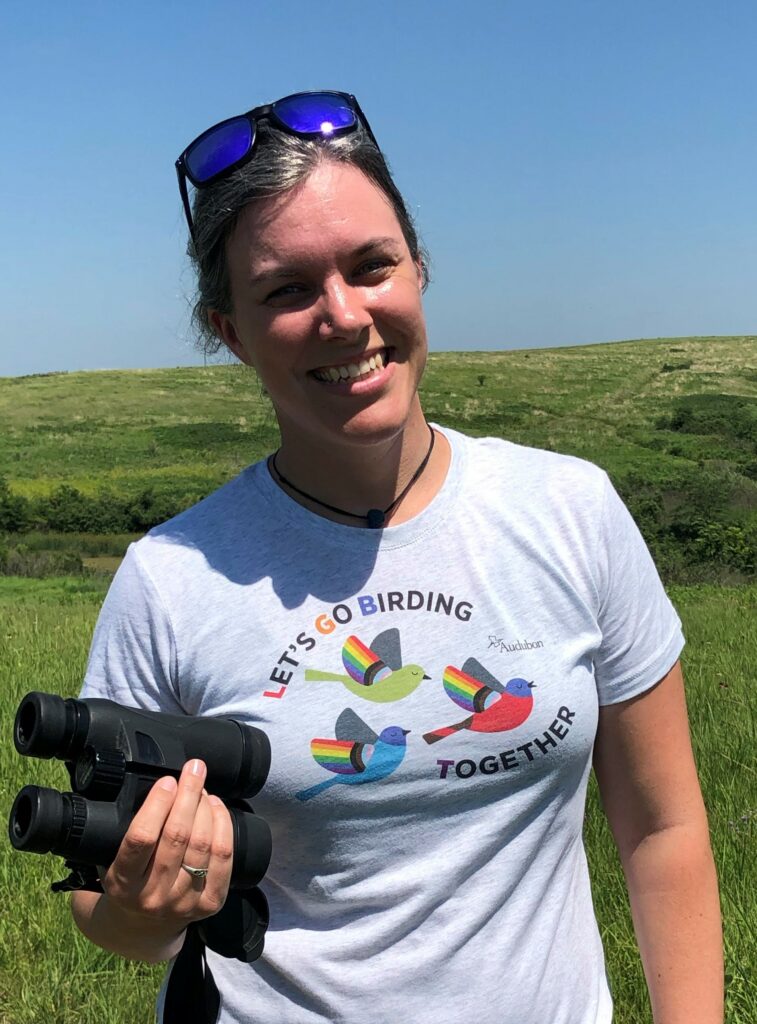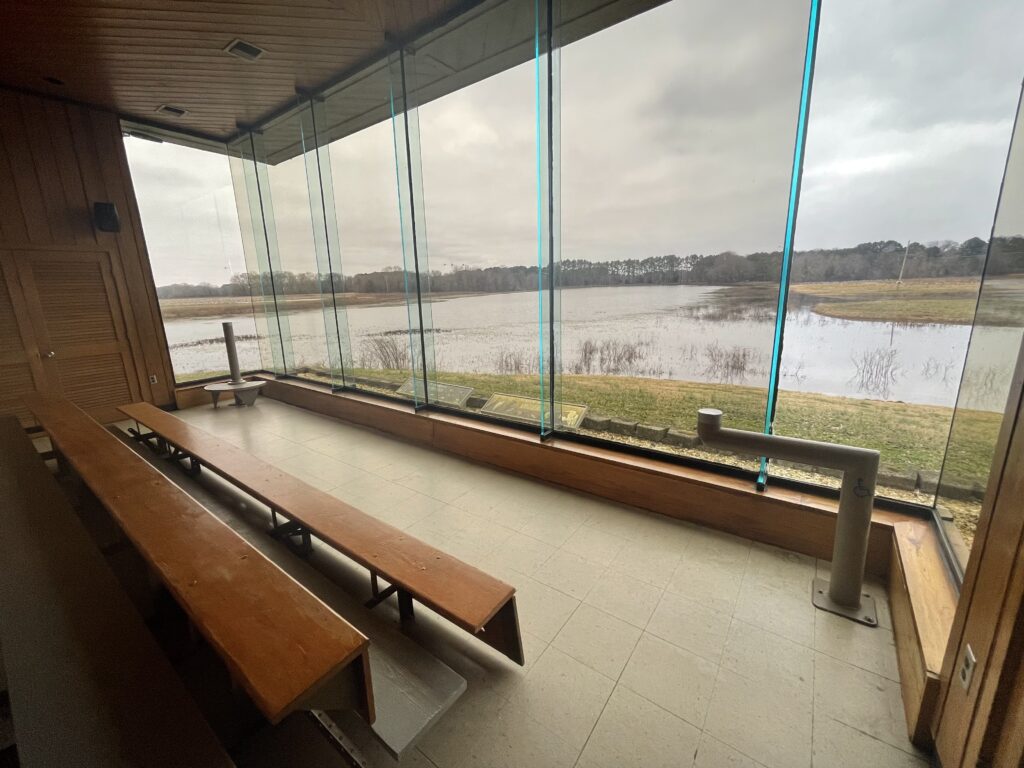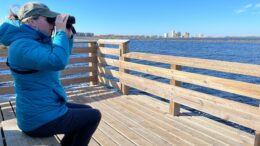Freya McGregor is adamant that anyone can be a birder. You don’t have to be able to identify the birds you see or keep lists of the rarities you’ve spotted. You don’t need binoculars — or even sight.
A broad definition of birding makes for a more inclusive community. So too, does attention to accessibility needs. McGregor knows this well — she’s a birder with a disability. She’s also an occupational therapist who works with people with blindness and low vision. And she runs a consulting company, Access Birding, that helps train staff and volunteers at nature organizations and public lands to improve access and inclusion for birders with disabilities.
“Disability is remarkably often left out of the conversation when talking about equity, diversity and inclusion in the outdoors — and in general,” she says. “Which is bizarre when you think about the fact that 1 in 4 Americans has a disability. It’s the only minority you can join at any time.” An estimated 5% of Americans experience short-term disability each year, and the rates of vision, cognitive and mobility disabilities rise as lifespans increase.
The Revelator spoke with McGregor about the joys of birding, what land managers can do to make birding more accessible and why we all benefit from inclusivity.
What is it that you enjoy about birding?
I grew up in Australia. My parents were birders, so I’ve had binoculars in my hand since I was a little kid. But then I was a teenager and it wasn’t really cool to be doing the things your parents enjoyed doing. So I was defiantly not a birder for most of my life.
Then I fell in love with an American and moved to the United States, and suddenly there were all these birds around that I didn’t just know what they were. I discovered that woodpeckers and hummingbirds are real. These are two families of birds we don’t have in Australia. My mind was blown. The transformation from not-a-birder to a birder was pretty quick after that.
I like wondering who is around, what birds are out and about today. I’m a military spouse, so I’ve lived in four states so far and there’s different birds in different places.
I love that birds can be the prompt to explore new places. Wondering what birds are out there can be a reason to broaden your horizons. For some folks that’s a new park or a new state or a new country. But it also could just be a trail in the neighborhood that you’ve never wandered down or that nice little patch of woods that you’ve just never checked out before.
Birds are an excuse to get outside and be out in nature. There are so many benefits to spending time in nature, including therapeutic ones, which I’m particularly interested in as an occupational therapist.

There are 45 million birders in the United States and a lot of folks go birding in community — in groups, as part of local bird outings and Audubon chapters. You can meet people and make friends.
How do we make it more accessible for people with disabilities?
Disability is so diverse and different folks with different disabilities have different access needs, but [for many] things like trail surface is important. Dirt trails that can get muddy are challenging to navigate. Getting stuck in gravel, grass and sandy trails isn’t super fun if you’re using a mobility device like a wheelchair or crutches or if you have balance issues.
Things like benches are also important. There are so many different people who need benches to have a rest. Every bench you add makes a difference.
There are also bird blinds — buildings that you go into and look at birds through windows that maybe are only at the height of standing people. So we need to have windows that are lower down for folks who are seated or folks who use wheelchairs. With observation platforms, hopefully there’s a ramp, not just stairs.
The safety barrier that’s trying to help you not fall off the edge is a good thing, but sometimes that top railing is really thick and if you’re in a wheelchair or a scooter there’s this five-inch piece of wood at your eye line. That’s a totally unnecessary barrier because there are all kinds of ways to design safety barriers that still keep visitors safe but don’t need to create such a big visual obstruction.
Maintenance is another really big one. Just because you build a really wonderfully accessible birding location, it won’t stay that way. Nature happens — trees fall and shrubs grow and start encroaching on the trail widths and potholes develop. If you’re not maintaining the area, it’s not going to stay as accessible as it could be.
There are all kinds of different access features of birding locations that can be really supportive or can create barriers that often they just don’t need to be there. It’s not that the land managers are trying to exclude folks, they often just didn’t think about it, which is a real shame.
Learning from the disability community is also important. Anytime you’re trying to serve a particular group of folks, you need to be learning from them because they’re the experts in what they need, not you.
What’s the best way to find out about whether a birding location is accessible?
The biggest thing is for nature preserves [or other public lands] to describe on their websites the access features that are present and to provide trail descriptions for all trails — not just the ones that they think are accessible. Share that information so people can make informed decisions about where they want to go. Is it worth driving two hours or is that observation blind steps-only and I can’t get in after all?
Tell me about every trail because everyone has different access needs. I have a dodgy knee, but I can do some slopes if my knee is doing well that day.
A state park might say on its website that a trail is “easy,” but what does that mean? Easy for whom? Are there benches? How many are there? What’s the surface? What’s the trail width? Are there any steep slopes?
Birdability is a nonprofit that I cofounded two years ago, and with National Audubon Society, we created the Birdability map to provide information about the accessibility of birding locations. Anyone can access it and find out that information ahead of time or submit a site review to the map of somewhere they visited.
Different adaptive sports or adaptive outdoor groups sometimes have this kind of information on their website too, although it’s often more local in scope.
I’m also working on a bird travel book. It’s the first one by a disabled birder for disabled birders and I’m writing about the physical accessibility of locations across North America.
I hope that will be a really helpful resource for disabled birders to find places that they should be able to be confident that they can visit with success and have a great experience. I hope it will also prompt other bird travel guide authors to consider this kind of information when they’re writing their books.

Who can be a birder?
Anyone. There are so many different ways to enjoy birds and birding. Any way you do it is valid, and you don’t have to do it in a particular way.
We can keep lists, or we don’t have to keep lists. We might enjoy the birds at our feeders. We might travel for birds. We might bird by car. We might bird through our computer by looking at nest cams and feeder cams because maybe you have chronic illness and can’t get out and go hike a trail. You can enjoy birds virtually.
You don’t even need binoculars. They’re helpful, but some people can’t use binoculars. They can’t hold them up. They’re too heavy. They don’t have upper limb strength or stability. They’re expensive, too. Not everyone can afford binoculars.
You don’t even need to see. My clinical background as an occupational therapist is in blindness and low vision services. And bird watching is only one way to enjoy wild birds because birds make sounds. And bird listening is just as valid as bird watching. Lots of folks who are fully sighted bird by ear just as much as birding by sight.
It’s really easy to make this hobby more inclusive and accessible. We just have to start thinking about what we’re actually trying to do and who we’re trying to serve.
What do we gain by more people being able to access nature and go birding?
There are individual benefits. We know that spending time in nature can help decrease feelings of anxiety and combat depression. It can also increase our attentional capacity, which is how much brain space you have to focus on something. We know that listening to bird songs can help improve people’s moods.
Even just seeing a tree out a window has therapeutic benefits. There’s research with women going through chemotherapy for breast cancer and sitting for 10 minutes on a bench in a garden helped improve their attentional capacity during treatment.
You don’t have to hike a mountain for five days. You just need little bits of nature. This is equity — everybody should be able to access those health and wellness benefits whether you have a disability or not. It should be a fundamental human right.
There are also community benefits, too. Birding can be a way to find a local community group to tap into and get social support.
The other really big reason to make nature and birding more accessible is that the more people who we can convince that birds are awesome and nature is cool, the more people they’ll be who can take action to help protect it. And the more people who are doing that, the better off we’re going to be on a planet that really needs as many people as possible helping care for it and act on behalf of it.
Get more from The Revelator. Subscribe to our newsletter, or follow us on Facebook and Twitter.
Previously in The Revelator:
![]()


